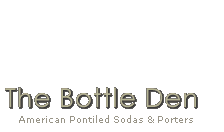Flint Glass of the Maryland Chemical Works ...
Article IV - One of America's Earliest Marked Bottles | back to Articles
by Wil Martindale
This month's featured article focuses on an early flint glass square marked: "MARYLAND--CHEMICAL/WORKS--BALTIMORE--CALCINED/MAGNESIA". This 3 7/8" square was excavated in old New Orleans, in a pit which contained a number of items which appeared to date to the 1820's.
Being familiar with early finds in Charleston, dating from the Colonial period to the 1830's, I recognized the early flint glass form as sharing characteristics with similar bottles, most of which are marked "LONDON". These early artifacts are usually dug alongside unmarked bottles, appearing to be of both Continental and American manufacture.
 I vaguely recall similar druggist style squares marked PHILADELPHIA or NEW YORK, but had seen none marked BALTIMORE prior to this example. I have also seen LONDON marked mustard squares in aqua with tubular open pontils (which many collectors believe to be American) but this example has a solid rod pontil scar and probably predates the open pontiled examples.
I vaguely recall similar druggist style squares marked PHILADELPHIA or NEW YORK, but had seen none marked BALTIMORE prior to this example. I have also seen LONDON marked mustard squares in aqua with tubular open pontils (which many collectors believe to be American) but this example has a solid rod pontil scar and probably predates the open pontiled examples.
Research shows that the Maryland Chemical Works was established in 1825, by one John J. McKim. So we know that the bottle was in use in Baltimore around that time or later--but was it produced there or shipped from England?
Though it was typical of early American glass houses to emulate continental forms, I do not know of embossed, solid pontil flint glass being produced in Baltimore during this period, and so I am inclined to attribute the manufacture of this bottle to England, closer to 1825 than 1829.
Further evidence to support this conclusion lies in a tantalizing piece of evidence regarding "McKim's Genuine Calcined Magnesia" in the 1829 publication of the American Farmer.
On page 111, where McKim's is compared to the more expensive "Henry's Calcined Magnesia" (presumably an English import) the Farmer states that McKim's product is "equal in all respects, and sold for little more than half the price". The last sentence of the article states that McKim's article "should be a subject of pride to Baltimoreans particularly, as it may be called a Baltimore product entirely--the glass having been made here, and the materials being obtained from the neighbourhood".
History documents the Maryland Chemical Work's importance in establishing a much needed domestic chemical manufacturing basis for the growing industrial trades of the newly United States-- to mitigate the high cost of the post war British import trade, and to further America's continuing independence from England.
If the plant's first bottles were English imports, the claim of being a completely self-sufficient operation could not be made, whereas domestic glass production would have been a noteworthy development--therefore, the mention of McKim's "glass having been made here" makes sense in this context.
But embossed bottles identifying an American city rarely predate the late 1820's. In fact, research indicates that any bottle so embossed from the mid-1820's would likely qualify as one of the earliest bottles bearing such embossing.
There is a clear, open pontiled 3 1/2" variant known marked "MARYLAND--CHEMICAL/WORKS--BALTIMORE" with a plain 4th panel, but this is a smaller bottle. Aqua o.p. variants are also known, but I believe this flint glass example to be one of the earliest embossed bottles made for the American market, and perhaps the earliest bottle marked "Baltimore" in existance.
